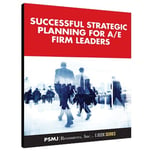 Each year we work with dozens of firms creating new strategic business plans (or updating existing ones). Our clients are small organizations and large ones, broadly diversified generalists and highly focused specialists, and in every A/E/C and environmental discipline imaginable.
Each year we work with dozens of firms creating new strategic business plans (or updating existing ones). Our clients are small organizations and large ones, broadly diversified generalists and highly focused specialists, and in every A/E/C and environmental discipline imaginable.
Additionally, we have conversations with several thousand professionals each year (in our training programs and conference events) concerning the key challenges and opportunities of managing and growing the business.
Most professionals understand what strategic planning is (at least generally), and a large percentage of them have had hands-on experience with this work. That said, many leaders and their organizations struggle to get a full return on their investment in planning. There’s a simple explanation for this shortfall: most of them are doing strategic planning all wrong.
A well-built strategic plan must include a combination of three parts: a comprehensive assessment of current reality, a compelling vision/mission for strategic context, and a detailed action plan that can actually be executed. Omitting any of these parts will render the plan (and planning process) much less effective. Shortcuts don’t work.
Now, some firms focus all their effort on the vision/mission piece, but without an action plan this is just too touchy-feely, and ultimately demotivating. Other companies do a bunch of action planning, but without the bigger picture there’s just not enough meaning in the plan. And almost no one does enough of the hard hitting, honest and candid assessment work needed to uncover what’s really going on.
Here are a few more of the common pitfalls in strategic planning that we routinely see, but that can be easily avoided:
Not enough effort - Good strategic planning requires a lot of work. Most leaders know this, but it’s tempting to try and shave off a corner here and there to reduce the time, effort, and cost of the program. Some firms want to decrease the retreat length (“Can’t we do this in just one day?”) or the depth of the assessment (“Do we really need to ask our clients?”). Some want to chop down the scope (“We don’t really need a vision, just some action items we can work on”). Others are focused on costs (“Let’s just hold the meeting here in our office.”). How about this thought: “Everyone’s already coming in for the ops meeting – let’s just talk strategy after that.” Look, if you’re not going to do it right – maybe you shouldn’t do it at all.
Too much effort - A few organizations make the opposite mistake, spending way too much time and effort on their plan. I was once hired by a CEO to help his team finish an in-progress strategic plan. This 100-persoon engineering firm had a plan alright - over 300 pages in length! I recommended an executive summary, but even that was 30 pages long. These guys were overly enamored with strategic planning, and they spent way too much time studying and analyzing. As a result they had little energy left to get anything done. Remember that the plan isn’t the goal – just the vehicle for reaching the goal.
Wrong people involved- While there’s not just one right answer, the question of who should be involved in strategic planning is an important one. It’s easier to build consensus within a smaller group, but easier to achieve buy-in if more are involved early. Owners, leader, managers, and other key staff often have an important stake in the future of the firm, and they are the ones to contribute most meaningfully to the process. Larger organizations usually need to form committees and workgroups to properly engage a larger team. Bottom line: you should include those people who can make it happen – the thinkers and the doers. And, when in doubt, err on the side of greater inclusivity.
Doing it yourself - Leaders usually take the DIY path for one of two reasons. Either they believe they can lead the process better themselves, or they just don’t want to spend the money on outside consultants. This first thought is a reasonable one, since strategic planning is often well understood and not so mysterious. Some leaders are in fact are quite effective, and their organizations do well without a lot of outside help. But for most firms this isn’t a good idea at all. While there may not be much rocket science conceptually, the real differentiator (the real magic) – comes through the breakthrough discussions (finally), and through the real implementation of initiatives. Your advisor should lead both of these parts much better than you can do alone.
No follow through - The greatest shortcoming (by far) of strategic planning is poor implementation, and the biggest reason for this is the lack of accountability in plan management. The consultant-facilitator should play an invaluable role here - monitoring the progress, managing the process, and holding team members to account. Too many firms spend all of their energy creating a plan and nothing executing it. That makes no sense – it’s completely backwards. Much better to have an imperfect plan, but with actual work progress. And a successful strategic plan doesn’t end with an action agenda; it also must include an explicit plan for marketing, communications, and execution.
No buy In – Sometimes an organization does (it seems) everything right, and still the plan goes nowhere. In professional services firms the most common reason for this is lack of alignment. (Perhaps we thought we had everyone on board, but it just wasn’t true.) If your strategic plan isn’t happening the way you expected (or the way you’d like), it’s time to cycle back to pick up those you can – and to decide what to do with those you can’t. Otherwise, you’re not going to move the dial much without stronger buy-in.
There’s a lot more to say about effective strategic planning – what’s included, who should be involved, how to get started. If you haven’t yet embarked on your first structured planning process – you should, and now. We believe that strategic planning is one of the most important, most leveragable, and highest return on efforts that a leader can undertake.
And if you’ve already completed a plan (or even been through several planning cycles) but still aren’t achieving all you want maybe it’s time for a reassessment of what you’re doing and how. It could be that you’re doing it all wrong.
 Looking for more tips, check out Successful Strategic Planning For A/E Firm Leaders.
Looking for more tips, check out Successful Strategic Planning For A/E Firm Leaders.
In this free e-book, you’ll find specific suggestions to help your architecture or engineering think of “planning” as something you do all the time, tending to it at regular intervals—as a process that never ends and an ongoing part of running a successful business.
Other strategic planning related blog posts:
8 Tips For Making Your Strategic Planning Meeting A Success
Get Strategic With These Planning Questions



